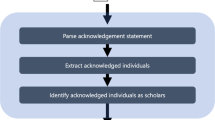Abstract
Acknowledgments in scientific and academic papers are a method of expressing appreciation and gratitude between scholars. Inside the acknowledgments section, authors usually thank different entities or individuals for their support, most commonly in terms of grants, suggestions and discussions. Social networks of authors and publications has been well studied, with an exhaustive study of nearly all network properties. However, to the best of our knowledge the social graph of acknowledgments have never been investigated. In this paper we propose building an acknowledgments graph, and study the relationships between the entities of this graph.
We first describe how to extract the acknowledgments section. We then extract the entities inside the acknowledgment section, classifying them into persons or organizations. After that we take a subset of the nodes and build a directed graph between the authors of these papers and the entities being acknowledged and study the characteristics of the resulting social network.
Access this chapter
Tax calculation will be finalised at checkout
Purchases are for personal use only
Preview
Unable to display preview. Download preview PDF.
Similar content being viewed by others
References
Borner, K., Dall’Asta, L., Ke, W., Vespignani, A.: Studying the emerging global brain: Analyzing and visualizing the impact of co-authorship teams. Complexity 10(4), 57–67 (2005)
Councill, I.G., Giles, C.L., Han, H., Manavoglu, E.: Automatic acknowledgement indexing: expanding the semantics of contribution in the citeseer digital library. In: Proceedings of the 3rd International Conference on Knowledge Capture (2005)
Cronin, B., McKenzie, G., Rubio, L., Weaver-Wozniak, S.: Accounting for influence: Acknowledgments in contemporary sociology. Journal of the American Society for Information Science 44(7), 406–412 (1993)
Cronin, B., Shaw, D., La Barre, K.: A cast of thousands: Coauthorship and subauthorship collaboration in the 20th century as manifested in the scholarly journal literature of psychology and philosophy. Journal of the American Society for Information Science and Technology 54(9), 855–871 (2003)
Cronin, B., McKenzie, G., Rubio, L., Weaver-Wozniak, S.: Accounting for influence: acknowledgments in contemporary sociology. J. Am. Soc. Inf. Sci. 44, 406–412 (1993)
Edge, D.: Quantitative measures of communication in science: A critical review. History of Science 17, 102–134 (1979)
Giles, C., Councill, I.: Who gets acknowledged: Measuring scientific contributions through automatic acknowledgment indexing. Proceedings of the National Academy of Sciences of the United States of America 101(51), 17599 (2004)
Glanzel, W.: Coauthorship patterns and trends in the sciences (1980-1998): A bibliometric study with implications for database indexing and search strategies.. Library Trends 50(3), 461–473 (2002)
Glanzel, W., Schubert, A.: Analysing scientific networks through co-authorship. In: Handbook of Quantitative Science and Technology Research, pp. 257–276 (2005)
Liu, X., Bollen, J., Nelson, M.L., Van de Sompel, H.: Co-authorship networks in the digital library research community. Inf. Process. Manage. 41, 1462–1480 (2005)
Nascimento, M., Sander, J., Pound, J.: Analysis of SIGMOD’s co-authorship graph. ACM SIGMOD Record 32(3), 8–10 (2003)
Newman, M.: Who is the best connected scientist? A study of scientific coauthorship networks. Complex Networks, 337–370 (2004)
Newman, M.: Coauthorship networks and patterns of scientific collaboration. Proceedings of the National Academy of Sciences of the United States of America 101(suppl.1), 5200 (2004)
Treeratpituk, P., Teregowda, P., Huang, J., Giles, C.: SEERLAB: A system for extracting key phrases from scholarly documents. In: Proceedings of the 5th International Workshop on Semantic Evaluation, pp. 182–185 (2010)
Author information
Authors and Affiliations
Editor information
Editors and Affiliations
Rights and permissions
Copyright information
© 2012 Springer-Verlag Berlin Heidelberg
About this paper
Cite this paper
Khabsa, M., Koppman, S., Giles, C.L. (2012). Towards Building and Analyzing a Social Network of Acknowledgments in Scientific and Academic Documents. In: Yang, S.J., Greenberg, A.M., Endsley, M. (eds) Social Computing, Behavioral - Cultural Modeling and Prediction. SBP 2012. Lecture Notes in Computer Science, vol 7227. Springer, Berlin, Heidelberg. https://doi.org/10.1007/978-3-642-29047-3_43
Download citation
DOI: https://doi.org/10.1007/978-3-642-29047-3_43
Publisher Name: Springer, Berlin, Heidelberg
Print ISBN: 978-3-642-29046-6
Online ISBN: 978-3-642-29047-3
eBook Packages: Computer ScienceComputer Science (R0)




